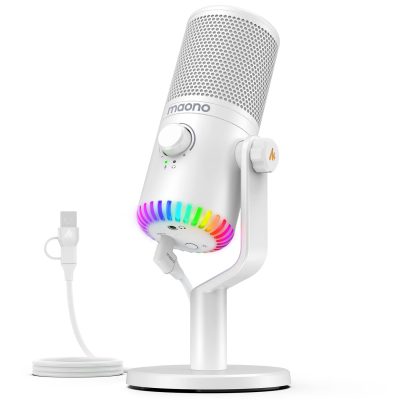When you’re putting together a high-quality streaming or recording setup, you can’t skimp on quality when it comes to your microphone. While your screen recording software is, of course, incredibly important, if you don’t sound great while you’re streaming or recording, then people will quickly switch off your stream and go elsewhere. That’s why you need to make absolutely sure that you have a high-quality microphone to give you that crucial edge.
Of course, it can be hard to know what a quality mic looks like, especially if you don’t want to spend a lot of money to get one. Many industry-standard mics have popped up again and again in the setups of streamers and content creators, but there’s no reason that challengers can’t rise up to take them on every now and again. Enter the Maono DM30, which is a nicely-priced mid-tier microphone designed for gamers. Let’s take a look at the DM30 and see what it can do!
Maono DM30 price – how much does it cost?
The Maono DM30 is a very competitive and attractively-priced microphone option. On the official Maono website, the microphone comes with a suggested retail price of just $49.99, which is significantly cheaper than many of the mics streamers use on a regular basis. Suffice it to say that if budget is a concern for you, the Maono DM30 is definitely going to be a good option. Sound quality isn’t immaterial even when the price is low, but you’ll likely feel that the DM30 punches above its weight class at such a low cost.
Maono DM30 release date – when can I buy one?
The good news is that the Maono DM30 is available right now! If you’re enticed by the features we’re about to list, then you can pick one up directly from the Maono website, or you can head over to Amazon or several other retailers to grab one if you prefer. Availability in the UK seems to be relatively scarce, but if you’re in the US, you shouldn’t have any problem picking one up. You could even import one if you’re willing to accept the cost of doing so!

Maono DM30 features – what kind of things does the mic do?
Whatever you might expect a gaming microphone to do, the DM30 pretty much does it. Of course, you’re not going to find some of the more advanced, higher-end features that many condenser mics geared towards musicians offer, but the DM30 is intended as a streaming or podcast mic, and it performs that function with aplomb. Let’s take a look at some of the DM30’s features.
- High sensitivity level. The DM30 is capable of picking up whatever you’re currently doing, whether that’s talking softly, clicking your mouse, or tapping away at your keyboard. As such, one of the things you’re going to have to do if and when yours arrives is figure out the optimal distance for the various sounds you’re going to be making. The sampling rate is high at 24bit/48kHz, so you’re getting crisp, clear audio from this mic.
- Built-in software. We’ll talk a little bit more about Maono’s proprietary mic software in a moment, but rest assured that you can control the DM30 with its own interface. The software controls everything from lighting to sound, and there are tons of more advanced features available if you’re not completely happy with the sound you’re getting out of the box.
- Cardioid pattern. If you’re new to microphone technology, “cardioid” refers to the way in which the microphone picks up sound. It essentially means that the mic is going to pick up sound in a roughly heart-shaped pattern (hence “cardioid”), meaning that it effectively dampens sound at its rear. This will come in handy if you’re worried about your mic accidentally picking up sounds around its circumference, and it also means you can experiment with some more interesting mic patterns if, for instance, you’re recording a musical instrument.
- Built-in 3.5mm jack for monitoring. If you want to know how your mic sounds directly, then you can plug in a set of headphones to the jack that’s built into the microphone. This lets you hear exactly what you’re going to sound like so that you can adjust levels before you even start recording. Of course, we’d recommend monitoring yourself alongside your game audio so you can get a more accurate picture, but this is still a neat feature nonetheless.
- USB connection. You won’t need to worry about using an audio interface to connect the DM30 to your PC. The mic doesn’t support XLR connections like dedicated music mics do; instead, it connects to your machine via USB, so as long as you have a port free, you’ll be able to hook the mic up.
- RGB lighting. That’s right – nothing in a gamer’s setup should be free of RGB lighting, and Maono clearly agrees, as the company has added it to this mic!
Maono DM30 software – what does it do?
Once you’ve connected the mic, you’ll want to fire up the DM30’s software as well. This allows you to control the lighting on the mic, as well as the sound quality, compression, equalisation, and much more. The software, which is called Maono Link, can be downloaded here, and after a quick installation process on Windows or Mac (Linux isn’t currently supported, unfortunately, although Android is), you’ll be able to exercise a greater degree of control over your mic’s appearance and its sound.

